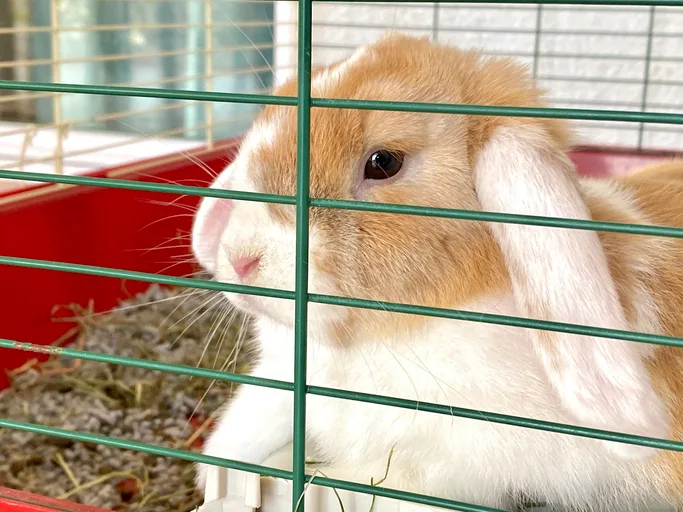Anorexia & Lethargy in a Rabbit
Karen L. Rosenthal, DVM, MA, Diplomate ABVP, University of Pennsylvania

A 5-year-old female intact French lop-eared rabbit is presented after not eating or defecating for 2 days and sitting hunched in the corner.
History
This is an only rabbit. It lives indoors in a cage and does not spend time unsupervised outside the cage. The rabbit had been brought to the veterinarian twice within the past year for not eating. The cheek teeth were clipped, and the rabbit started eating within a day. The rabbit eats a poor-quality pellet diet with hay and greens on occasion.
Physical Examination
The rabbit lost 0.5 kg since the last visit 5 months ago. There is no evidence of "slobbers," nor were points seen on awake otoscopic examination of cheek teeth. No gut sounds were heard during auscultation of the abdomen. The rabbit was very tense, precluding a thorough abdominal palpation.
Laboratory Work
A CBC, biochemistry profile, and urinalysis were done. Results of the CBC were unremarkable except for a hematocrit of 28% with a regenerative response. All biochemistry values are within the normal range. Urine was obtained by free-catch. Urine specific gravity was 1.026, red blood cells were too-numerous-to-count, and a large amount of calcium sediment was noted. Radiographs (Figures 1 and 2) and a thorough dental examination were also indicated.


Differential Diagnosis
The most challenging aspect of this case is the nonspecific signs of illness, and the physical examination was unhelpful in narrowing the rule-out list. The list of problems includes anorexia, poor diet, ileus, blood in urine, anemia, and dental disease.
Ask Yourself ...
This rabbit has never been bred. What is the likelihood that reproductive disease is causing its problem?
If the rabbit is anemic from blood loss in the urine, why wasn't this noticed by the owners?
How likely is it that this rabbit has dental disease despite the fact that no lesions were seen on examination and there was no history of tooth grinding?
No straining was noticed by the owners, how likely is it that urinary tract disease is associated with this problem?
Diagnosis
Uterine adenocarcinoma
A soft-tissue opacity is apparent on the lateral radiograph (Figure 2) between the bladder and colon. Laparotomy was performed. What was removed is shown in Figure 3. Histopathology results revealed uterine adenocarcinoma. Uterine adenocarcinoma is a slow-growing tumor. Removed early in disease, the cancer is curable by ovariohysterectomy; no ancillary treatment is required. In this case the uterus was removed and there were no signs of metastasis. The rabbit was doing well when presented a year later for a checkup. Uterine adenocarcinoma is common in unspayed female rabbits. The only sign may be blood in the urine. In this case, the red urine did not alert the owners because the patient has had a history of porphyrin-colored urine and the red coloring from blood looked no different from porphyrin pigments.

Dental disease may cause anorexia, and subtle lesions may only be seen while the rabbit is sedated. Because the rabbit required sedation for the radiographs, this opportunity was taken to examine the oral cavity. No dental points or soft tissue ulcers were observed, but dental disease can be present even with a normal examination. Skull radiographs were necessary to definitively rule out dental disease.
The low-fiber diet of this rabbit (common in pet rabbits) can lead to ileus.
The radiographs revealed no urinary tract calculi or "bladder sludge." Urinary tract calculi or sludge may only cause the rabbit to become lethargic and anorexic; signs of urinary disease may not be seen. Urinary tract disease is common in rabbits and may only present as nonspecific disease.
Did You Answer ...
Uterine disease is a frequent finding among intact rabbits that have never been bred.
There is a history of porphyrin-colored urine; the color may not differ noticeably from that of bloody urine.
An oral examination under sedation was necesary to rule out dental disease. Sometimes skull radiographs are also necessary to rule out dental disease.
Urinary tract calculi or "bladder sludge"should be considered in any case of nonspecific illness in a rabbit.
Possible Diagnoses
Anorexia and ileus due to improper diet
Ileus can be a consequence of poor diet and/or dental disease. The fiber concentration is probably low, as pellets are the primary dietary offering. In addition, the calorie content is probably too high.
Dental disease
The history of anorexia resolving with tooth clipping puts dental disease on the list even with a lack of lesions. A thorough dental examination under sedation with skull radiographs can best rule out dental disease.
Reproductive disease
The regenerative anemia probably is related to the blood in the urine, which could be the result of a diseased uterus. Diseases include pyometra, neoplasia, and aneurysm.
Urinary tract disease
Blood in the urine could also be due to a urinary tract infection, calculi, neoplasia, or "bladder sludge."